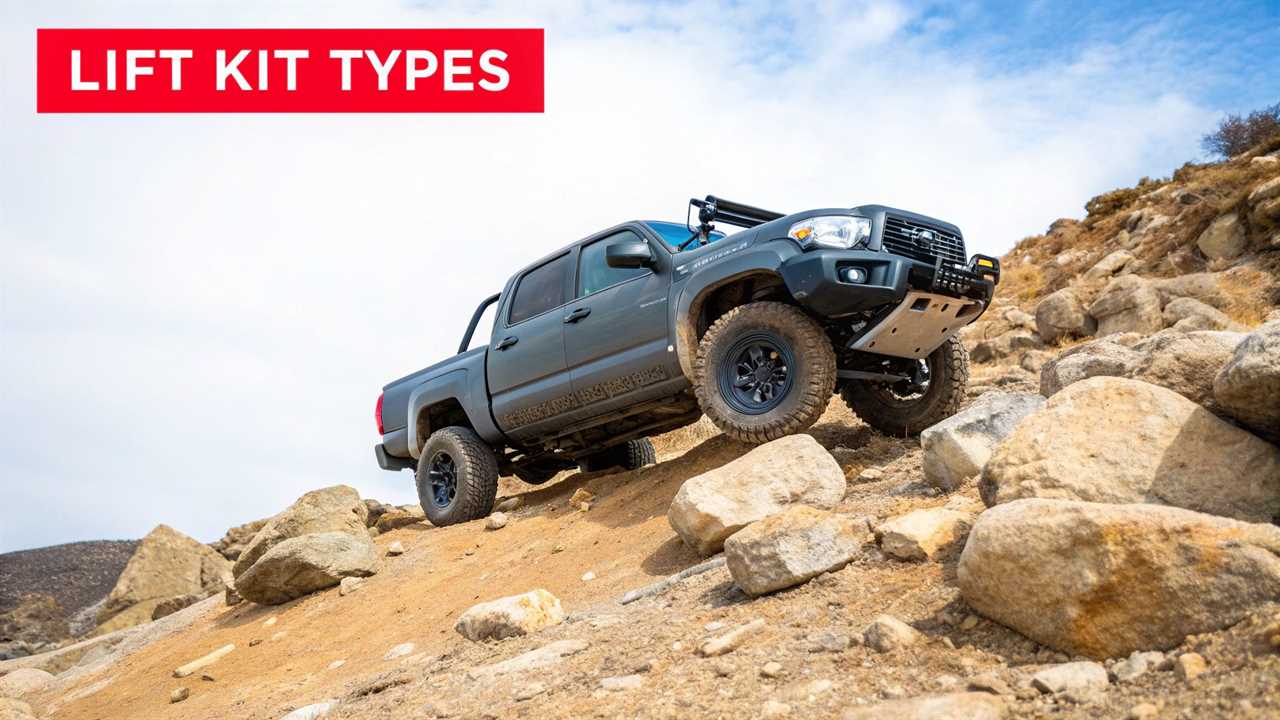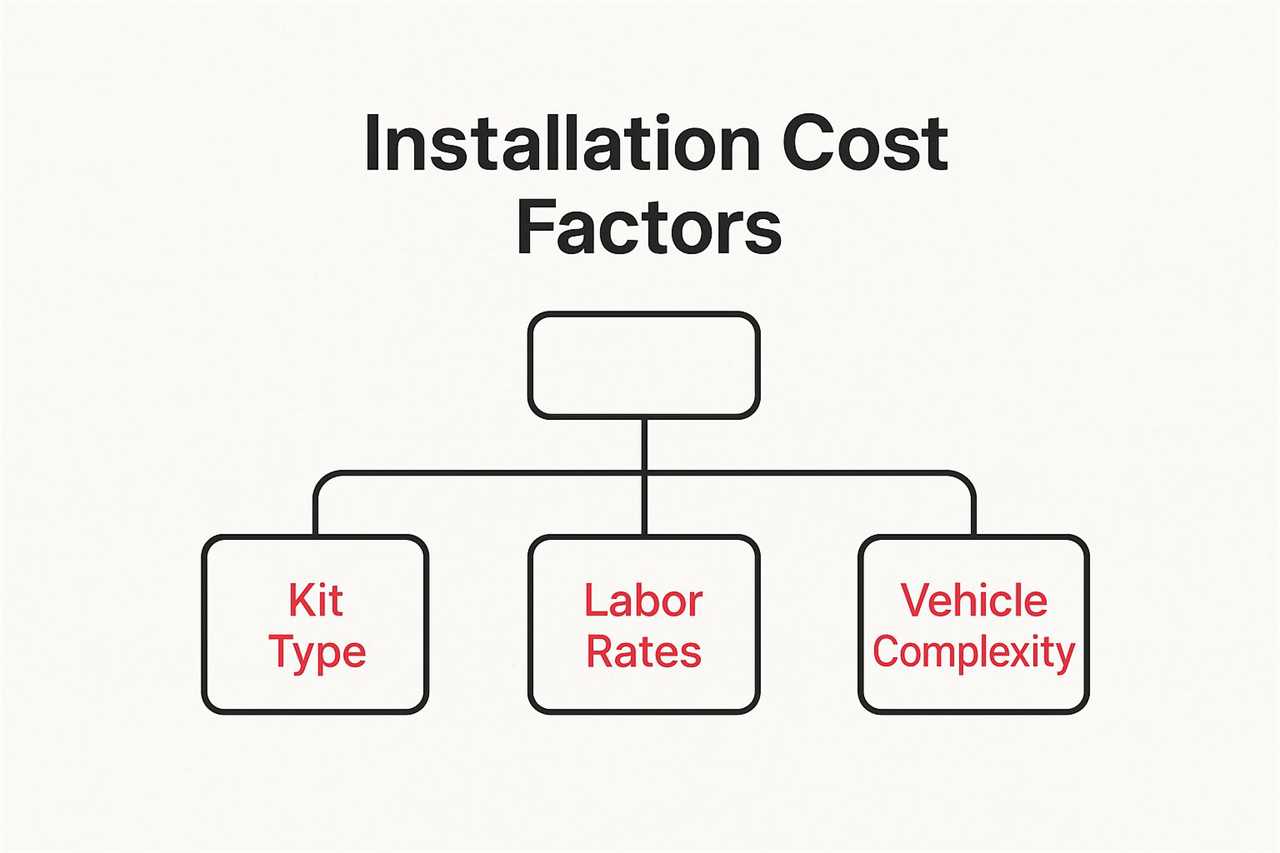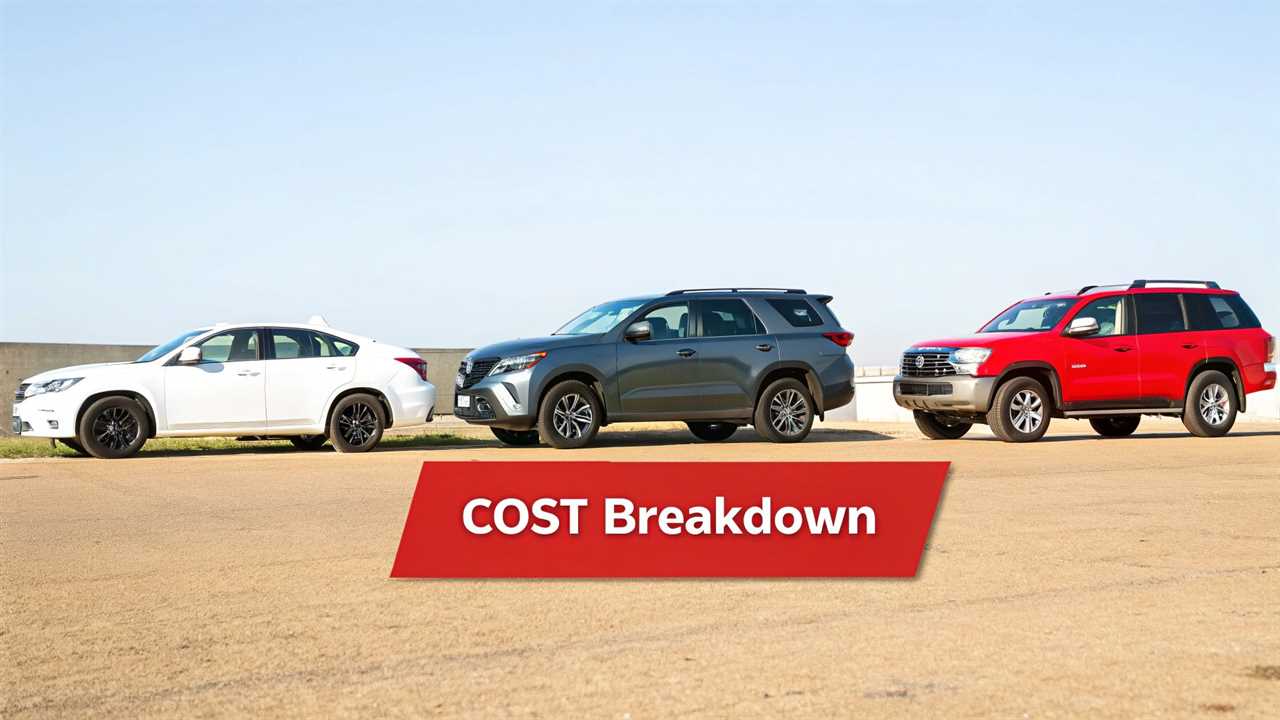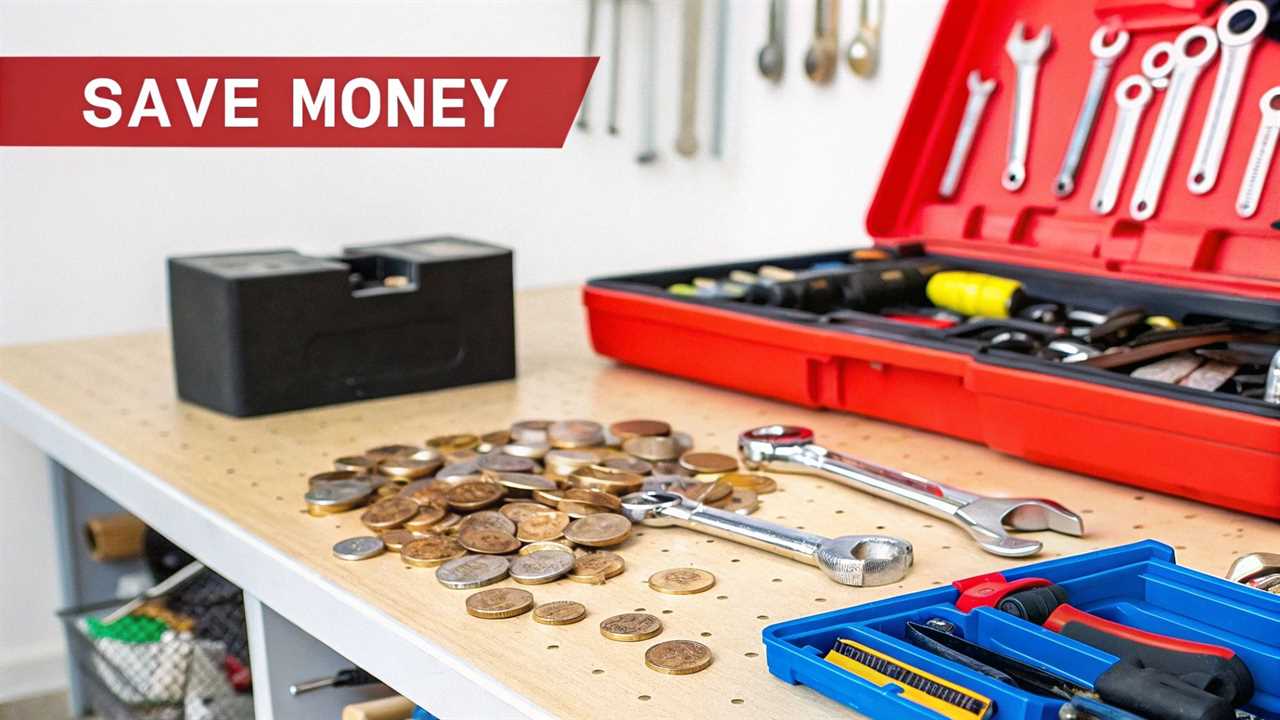So, you’re thinking about lifting your truck. The first question that probably pops into your head is, “How much is this going to set me back?” The short answer is that a lift kit installation cost can run anywhere from $400 to $5,000.
It’s a huge range, I know. The final price tag really boils down to what kind of kit you choose, the truck you’re putting it on, and whether you’re paying a pro to do the heavy lifting. A simple leveling kit might only be a few hundred bucks installed, but a full-blown suspension system can easily climb into the thousands.
This guide will walk you through all the moving parts so you can figure out a realistic budget.

What Is the Real Cost to Install a Lift Kit?
Let’s cut to the chase. The total cost isn’t just one number. It’s a mix of parts and labor, kind of like the difference between a car’s sticker price and its “out-the-door” cost. The kit itself is your starting point, but unless you’re a seasoned mechanic, professional installation is a major—and necessary—expense.
Your final bill is a two-part equation: the price of the lift kit itself plus the shop’s hourly rate. For instance, a basic leveling kit is a pretty straightforward job, so labor costs stay low. A comprehensive suspension lift, on the other hand, means swapping out major components. It’s a much bigger job that takes more time and expertise, driving up the labor bill significantly.
A Quick Financial Snapshot
For a pretty standard setup, like a 6-inch suspension lift with some beefy 35-inch tires, you’re likely looking at a total bill somewhere between $1,500 and $2,500. That number bundles the kit and the professional install, which requires specialized tools and a good chunk of a mechanic’s day.
Key Takeaway: When you’re budgeting for a lift, don’t just look at the price of the kit. The labor is a critical part of the equation that ensures your truck is safe, properly aligned, and ready for whatever you throw at it.
To give you a better idea of where your project might land, I’ve put together a quick cheat sheet. This table gives you a bird’s-eye view before we dive into the nitty-gritty details of each option.
Estimated Lift Kit Installation Cost at a Glance
This table breaks down the estimated total costs, including parts and labor, for the most common types of lift kits. It’s a great starting point for figuring out what you can expect to spend.
| Lift Type |
Lift Height |
Estimated Total Cost (Parts & Labor) |
Best For |
| Leveling Kit |
1-2.5 inches |
$400 – $1,000 |
Correcting factory rake, fitting slightly larger tires |
| Body Lift Kit |
1-3 inches |
$600 – $1,500 |
Purely aesthetic lift for tire clearance, no performance gain |
| Suspension Lift Kit |
2-6+ inches |
$1,500 – $5,000+ |
Serious off-road performance and maximum tire clearance |
Once your truck is lifted, keeping it in top shape is just as important as the installation itself. To make sure everything stays running right, it’s a good idea to follow a detailed truck maintenance checklist to stay on top of all the post-lift care.
How Different Lift Kits Affect the Price Tag
By far, the biggest factor driving your total lift kit installation cost is the kit itself. It’s a lot like walking into a camera store: a simple point-and-shoot gets the job done for casual photos, but a professional DSLR with a bag full of lenses gives you way more capability—and comes with a much steeper price. Lift kits work on the exact same principle.
The massive price gap between a $300 kit and a $3,000 one boils down to three things: complexity, components, and purpose. Are you just looking for a subtle cosmetic change, or are you building a serious off-road machine? Your answer will point you toward one of three main types of lifts: leveling kits, body lifts, or full suspension systems. Each one offers a different level of performance and, you guessed it, a different price.
Leveling Kits: The Budget-Friendly Tweak
The most affordable way to get started is with a leveling kit. These kits are built to fix a common quirk on most trucks called “factory rake.” Trucks usually leave the factory sitting a little lower in the front to help with aerodynamics and to prevent sagging when the bed is loaded down. A leveling kit simply raises the front end by an inch or two to match the rear, giving your truck a more aggressive and balanced stance.
Because they’re so simple—often just a pair of strut spacers—the parts are cheap. The installation is also pretty straightforward, usually only taking a few hours. This makes leveling kits a great choice if you’re mainly focused on looks or want to squeeze in slightly larger tires without breaking the bank.
Body Lifts: The Purely Aesthetic Choice
A body lift is another cost-effective route to gaining some height. Instead of touching your suspension at all, these kits use heavy-duty nylon or polyurethane blocks to physically lift the truck’s body up and away from its frame. This gives you more clearance for bigger tires without messing with your factory ride quality or suspension geometry.
Keep in mind, though, a body lift is all for show. It gives you zero off-road performance benefits and can leave a noticeable gap between your frame and body that some people find unappealing. While it’s cheaper than a full suspension lift, it’s a cosmetic mod, not a functional upgrade.
Suspension Lifts: The Ultimate Performance Upgrade
This is where the lift kit installation cost really starts to climb. A true suspension lift kit swaps out major factory parts—we’re talking shocks, springs, control arms, and more—to physically lift the entire vehicle. It’s the only way to genuinely increase ground clearance and dramatically boost your truck’s off-road capability.
The infographic below breaks down the key factors that add up to the final bill.

As you can see, the type of kit you choose is the foundation for all the other costs involved.
The core principle is simple: more parts and more complexity mean a higher cost. A suspension lift is an investment in your truck’s performance, allowing it to handle rougher terrain with improved articulation and stability.
In the U.S. market, leveling kits and full suspension lifts are the two most popular options. Leveling kits usually run between $100 and $500 for the parts alone, giving you that small aesthetic boost. On the other end of the spectrum, full suspension lift kits can range from $1,000 to over $5,000 for just the kit, as they are engineered for serious performance. You can check out more details about these differences at TruckRanch.com. At the end of the day, what you’re really paying for is capability.
Professional Install vs. DIY: Which Path Saves You More?
Deciding who installs your lift kit is one of the biggest forks in the road you’ll hit. It’s the classic battle of money versus time, convenience versus control. In one corner, you’ve got professional installers with all the right tools and years of experience. In the other, you have your own garage, a set of instructions, and the chance to save a serious chunk of change on labor.
But does going the DIY route really save you more in the long run?

The answer isn’t as simple as comparing a shop quote to zero. You have to look at the full picture for each path, including the hidden costs and potential headaches.
The Professional Installation Route
Hiring a pro shop is the most straightforward—and often the safest—option, especially when you’re dealing with complex suspension lifts. You’re not just paying for a mechanic to turn wrenches; you’re paying for expertise, efficiency, and some much-needed peace of mind.
Most reputable off-road shops charge somewhere between $100 and $200 per hour for labor. A simple leveling kit might only take them 2-3 hours, but a full 6-inch suspension lift is a whole different animal.
A complex suspension lift can easily take 7 to 15 hours for a certified technician to install correctly. This isn’t just about bolting on parts; it’s about making sure every single component works together safely and performs as it should.
When you pay for a professional installation, you’re really investing in:
- Specialized Tools: Shops have hydraulic lifts, heavy-duty spring compressors, and other expensive gear that most of us don’t have lying around in the garage.
- Experience: These technicians have seen it all. From impossibly rusted bolts to tricky modifications, they know how to handle the curveballs without breaking something else.
- Warranty and Liability: If a part fails because of the installation, a good shop will stand behind their work and make it right.
This path gives you a predictable outcome and is definitely the way to go if you aren’t already a seasoned mechanic.
The DIY Installation Path
Tackling the install yourself is incredibly tempting. The biggest draw, of course, is saving on those labor costs, which can easily climb to $1,000 or more for a big job. But that “free” labor comes with its own price tag.
Before you start clearing out the garage, think about the true cost of a DIY project. You’ll likely need to buy or rent some specialized tools. A good floor jack, heavy-duty jack stands, and a reliable torque wrench are just the start.
The time commitment is also huge. A job that takes a pro 8 hours could easily eat up your entire weekend, or even longer if you hit a snag. And the biggest risk? Making a costly mistake. An incorrectly installed component can lead to serious safety issues on the road or trail, or even damage other parts of your truck, completely wiping out any money you thought you saved.
You also need the skills to handle the unexpected, which is where real-world mechanical experience comes in handy. For instance, knowing how to properly use a winch shows a level of comfort with mechanical systems that goes way beyond just following instructions. If you’re not confident working on complex vehicle systems, the DIY path might not be the cost-saver it seems to be.
Uncovering the Hidden Costs of Lifting Your Truck
So you’ve got a quote for the lift kit and the shop’s labor. That’s your total price, right? Not so fast. The number on that initial estimate is just the starting line, and many truck owners get a nasty surprise when the final bill comes due. The lift kit installation cost almost always creeps up with a few extra expenses.
These aren’t just sneaky upcharges to pad the bill. They’re absolutely essential follow-ups to make sure your truck performs correctly and, more importantly, safely after the lift. Think of it like a major home renovation—the quote for the new kitchen cabinets doesn’t include the new appliances or the fancy backsplash you’ll inevitably want.
The Non-Negotiable Follow-Ups
Once that lift kit is bolted on, your truck’s factory geometry goes right out the window. The single most critical task after the install is a professional wheel alignment. Skipping this is a recipe for disaster. You’re looking at terrible handling, chewing through expensive new tires in record time, and putting a ton of stress on your shiny new suspension parts. Any reputable shop will insist on it, adding $100 to $200 to your final invoice.
Got a newer truck? Then get ready for another big one: recalibrating the Advanced Driver Assistance Systems (ADAS). All those fancy features like adaptive cruise control, lane-keeping assist, and automatic emergency braking depend on cameras and sensors that were perfectly aimed at the factory.
Lifting your truck completely changes the angles those sensors are looking at, making them useless or, worse, unreliable. Getting them recalibrated is a specialized job that can run anywhere from $300 to over $700, but it’s a must-do if you want those modern safety features to actually work.
Globally, the total investment to lift a truck can be as little as $100 for a simple DIY leveling kit or as much as a jaw-dropping $15,000 for a top-of-the-line system with professional installation. As you can see from insights on RealTruck.com, this huge range makes it critical to budget for everything—not just the kit itself.
Your Pre-Build Financial Checklist
Of course, the biggest “hidden” cost is usually a new set of tires. Let’s be honest, almost nobody lifts a truck to keep the stock rubber. You’re doing it to fit bigger, meaner tires. A quality set of off-road tires can easily tack on another $1,000 to $2,500 to your project—a huge chunk of change that many people forget to include in the initial budget.
To make sure you’re working with a realistic number, it pays to map out all the potential add-ons before you start. Here’s a quick look at the most common expenses that pop up.
Potential Additional Costs for Lift Kit Installation
This table breaks down the common services and parts you’ll likely need to budget for beyond the kit and basic installation labor.
| Additional Service or Part |
Reason It’s Needed |
Estimated Cost Range |
| Wheel Alignment |
Corrects suspension geometry to prevent unsafe handling and uneven tire wear. |
$100 – $200 |
| ADAS Recalibration |
Re-aims safety sensors (cruise control, lane assist) to work correctly at the new height. |
$300 – $700+ |
| Larger Tires |
The primary reason for most lifts; needed to achieve the desired look and off-road grip. |
$1,000 – $2,500+ |
| New Wheels |
Often necessary if the new, larger tires require a different width or offset. |
$800 – $2,000+ |
By planning for these expenses from day one, you can dodge any budget-busting surprises. This way, your lifted truck project goes smoothly from the first wrench turn to the final test drive.
Matching the Right Lift to Your Goals and Budget
Knowing the numbers behind a lift kit installation cost is a great start, but it’s only half the story. Now we need to connect those dollars and cents to what you actually want to do with your truck.
Let’s be real: not everyone is building a sky-high, rock-crawling monster, and that’s perfectly fine. The real secret to being happy with your purchase is matching your investment to your lifestyle. This way, you avoid dropping a ton of cash on hardcore capabilities you’ll never actually use.
It’s like buying a new laptop. A professional video editor needs a beast of a machine that costs a small fortune. But if you just need to check email and browse the web, a basic model will do just fine. Your truck is no different. Let’s break down the most common goals to find your perfect fit.
The Daily Driver Building an Aggressive Stance
Is your truck your daily ride, tackling city streets and highways, but you’re craving that commanding, lifted look? This is one of the most common reasons people lift their trucks. The main goal here is aesthetics—getting that aggressive stance and fitting bigger tires without ruining your daily commute or emptying your wallet.
For this kind of build, a massive suspension lift is usually way more than you need.
- Recommended Kit: A leveling kit or a simple 1-3 inch body lift. These give you just enough height to get the look you want and clear some slightly larger tires.
- Realistic Budget: All in, you should expect to spend between $400 and $1,500 for the kit and installation. The kits are simpler, and the labor hours are much lower.
- Practical Trade-Offs: You get the tough look you’re after for a very reasonable price. The catch? These kits do little to nothing for your actual off-road performance. But for a daily commuter, the big win is that your ride quality should stay very close to the factory feel.
The Weekend Warrior Seeking Trail Capability
Do your weekends involve getting lost on purpose down dirt roads, splashing through muddy trails, or maybe some light rock-hopping? If you need your truck to actually perform when the pavement ends, your focus has to shift from just looks to real-world capability. You need more than just height—you need better ground clearance, more suspension travel, and parts that can take a beating.
A true performance upgrade means investing in the suspension itself. This is the point where your lift stops being a cosmetic choice and becomes a functional tool for your adventures. Your budget has to reflect that.
This is where a suspension lift kit is the only real answer. It’s a bigger investment, for sure, but it’s the only way to get legitimate off-road gains.
- Recommended Kit: A 2-4 inch suspension lift. This is the sweet spot, giving you a serious boost in ground clearance and wheel articulation without making your truck too extreme for daily driving.
- Realistic Budget: You’ll want to plan for a total installed cost of $1,500 to $4,000+. This budget covers a quality suspension kit and the much more involved labor, which can easily take 7-15 hours for a pro to do right.
- Practical Trade-Offs: The payoff is huge in terms of off-road capability. The trade-off is the higher upfront cost and a ride that might feel a bit stiffer on the street. As you start hitting more serious trails, you’ll also quickly realize the need for good gear organization. Having a solid truck bed cargo management system becomes crucial for keeping your equipment secure and making the most of your space.
Answering Your Top Questions About Lift Kit Costs
Alright, so we’ve torn down the big pieces of the lift kit installation cost. By now, you’ve probably got a few specific questions still rattling around in your head. This is totally normal.
Let’s clear up those final, nagging concerns about warranties, performance, and how to spot a trustworthy installer. Think of this as the last Q&A you’ll need before you’re ready to make a move.

We’ve pulled together the most common questions we hear from truck owners just like you and laid out some straight-shooting answers to help you lock in your decision.
Does Installing a Lift Kit Void My Truck Warranty?
This is the big one, the question that keeps owners of new trucks up at night. The short answer is no, it doesn’t automatically void your entire warranty. Thanks to the Magnuson-Moss Warranty Act in the U.S., a dealer can’t just throw out your coverage because you bolted on an aftermarket part.
But—and this is a big but—there’s a catch. The dealer has to prove that your lift kit directly caused the specific part to fail. For example, say you install a beefy 6-inch lift and a few months later a CV joint gives out. If the dealer can show the failure was due to the new, extreme angle of the axle, they can deny the warranty claim for that CV joint. Your engine, radio, and transmission coverage, however, are still perfectly safe.
Key Insight: To sidestep any potential warranty drama, some guys go straight to the dealership for the install or stick with manufacturer-approved kits (like the ones from TRD or Mopar). It’s the safest route for peace of mind, but it’s almost always the most expensive one.
How Will a Lift Kit Affect My Fuel Economy and Ride Quality?
You can bet you’ll see a change in both. Lifting a truck makes it taller and less aerodynamic, which means more wind resistance. Throw in the heavier wheels and beefier tires that almost always come with a lift, and you’re guaranteed to see a drop in MPG. The higher you go, the more fuel you’ll burn. It’s that simple.
Ride quality is a different story. It can go either way, and it all boils down to the quality of the kit you buy.
- Premium Suspension Lifts: A top-shelf kit with high-performance shocks and springs can actually make your truck ride better than stock, especially off-road. You get more control and capability.
- Cheaper Kits: On the flip side, basic spacer or body lifts often make the on-road ride feel harsh, stiff, and bouncy. That’s because you’re not actually upgrading the suspension components that do the real work.
It’s the classic trade-off. You’re giving up some daily-driver comfort and a few MPGs in exchange for that awesome look and serious off-road prowess.
How Do I Find a Reputable Shop for the Installation?
Picking the right installer is every bit as crucial as picking the right kit. A botched installation can turn even the best parts into a nightmare. Your first move should be to hunt down a specialized off-road or truck customization shop—not your average corner mechanic.
Start by hitting Google for reviews and then dive into local truck forums or Facebook groups. A shop that’s proud of its work will have a gallery of projects to show off. They should also be willing to walk you through your options and give you a detailed, itemized quote breaking down the lift kit installation cost.
Don’t be afraid to ask them directly about their experience with your specific truck model. The best approach? Get quotes from at least two or three qualified shops. This lets you compare not just the price, but their vibe, their expertise, and their customer service. You’ll quickly get a feel for who you can trust with your rig.
At Offroading.com, we’re dedicated to helping you tackle every part of your off-road journey with confidence. From choosing the right gear to understanding the costs, our expert guides are here to support you. Explore more at https://www.offroading.com.
https://offroading.com/lift-kit-installation-cost/?utm_source=rss&utm_medium=rss&utm_campaign=lift-kit-installation-cost
Did you miss our previous article...
https://manstuffnews.com/4x4-off-road-cars/synthetic-winch-rope-vs-steel-cable-which-is-better
 Backyard GrillingWeekend WarriorsAdvice from DadBeard GroomingTV Shows for Guys4x4 Off-Road CarsMens FashionSports NewsAncient Archeology World NewsPrivacy PolicyTerms And Conditions
Backyard GrillingWeekend WarriorsAdvice from DadBeard GroomingTV Shows for Guys4x4 Off-Road CarsMens FashionSports NewsAncient Archeology World NewsPrivacy PolicyTerms And Conditions
